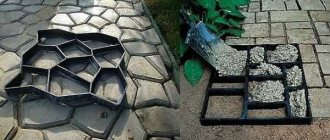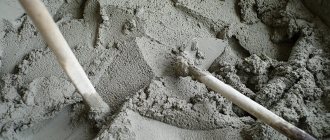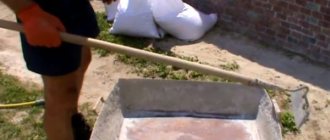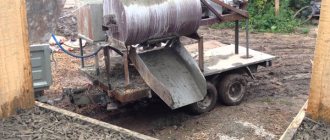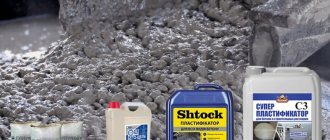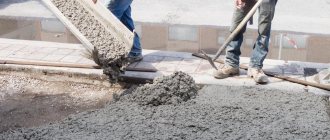For hundreds of years, concrete has been one of the most common types of building materials for the construction of structures of any purpose and size. Foundations, frames, supporting and enclosing structures, fences, and even roads are made from it. At the same time, builders most often give preference to concrete grade M300.
Concrete mortar grade M300 with the correct ratio of components can be ordered on the website “Concrete 174”
After all, this material not only has sufficient strength to perform most tasks, but also sets quickly and is relatively inexpensive. Compliance with the proportion of concrete M 300 is the main requirement in its production; many other parameters depend on this indicator.
M150 (B10)
This brand is suitable for constructing screeds, floors or foundations for light buildings on good soils. It can also be used to pre-level foundation pits before pouring stronger structural concrete.
Composition of concrete mix M150:
| Cement brand | Cement, bags | Sand, buckets | Crushed stone, buckets | Water, buckets | Concrete yield, liters |
| 400 Ш II/А-Ш 32.5 B | 1 | 6 | 14 | 4 | — |
| 400 Ш II/А-Ш 32.5 N | 1 | 7,5 | 12 | 3,5 | — |
| 400 W II/H-W 32.5 N | 1 | 11,5 | 16,5 | 4 | — |
| 500 I 42.5 N | 1 | 13 | 17,5 | 4,5 | — |
| 500 II/A-Sh 42.5 | 1 | 11 | 14 | 4 | 210 |
Choose proportions so that the volume of mixed components fills no more than 50% of your concrete mixer. Otherwise, there is a high risk of improper mixing and substandard quality.
For example, with a 120 liter mixer, reduce the amount of all ingredients by 4 times from those indicated in the table. In this case, the volume of the finished concrete mixture will be about 50 liters, and the concrete mixer will easily mix it. For mixers with a volume of 190-220 liters, the amount of fillers should be halved. As a result, the yield of concrete mixture will be 105 liters.
Features of application
The proportion of the concrete solution is an important factor, taking into account which a high quality material is obtained. At the same time, other rules should be followed to simplify the work and reduce concrete consumption:
- when choosing crushed stone, they give preference to one whose strength is approximately twice that of the concrete grade - in this case, 600 kgf/cm2. This makes it possible to reduce the deformation of the structure when the solution hardens and gains strength (on average, about six months);
- Limestone grade 500 or 600, and even gravel with a density of 800–1000 kgf/cm2 can be used as a filler for this concrete;
- the diameter of the crushed stone grain should not exceed 50 mm. The best option is fractions measuring 5–20 mm.
When mixing the composition, ensure complete absorption of water. This homogeneous mixture is best obtained by using a concrete mixer. However, if the proportions of the components of M300 concrete are chosen incorrectly, regardless of the quality of mixing, voids may appear in the material. And this will worsen the performance characteristics of the concrete structure and lead to their destruction ahead of schedule.
M200 (B15)
The recipe for a concrete mixture of grade 200 is suitable for the foundations of small houses, bathhouses and outbuildings. This brand is also used in the manufacture of blind areas, floors, pouring platforms, and concreting fence posts.
Recipe for ready-mixed concrete M200:
| Cement brand | Cement, bags | Sand, buckets | Crushed stone, buckets | Water, buckets | Concrete yield, liters |
| 400 Ш II/А-Ш 32.5 B | 1 | 5 | 12 | 3,5 | — |
| 500 II/A-Sh 42.5 | 1 | 10 | 13 | 3,5 | 190 |
| 500 II/A-3 42.5 | 1 | 10 | 12 | 4 | — |
If you need to calculate the number of ingredients to obtain one cube of the mixture, then here is a recipe for 1 m200 cube of concrete from “five hundredth” cement with slag:
- Cement – 5.3 bags (0.265 tons);
- Sand - 53 buckets (0.795 tons);
- Crushed stone - 68 buckets (1,026 tons);
- Water – 18.5 buckets (0.185 m3).
The proportions are additionally given in tons and will be convenient if the volume of concrete required is known, but you need to calculate how much bulk materials to order.
Area of use
High levels of strength, frost resistance and water resistance determined the scope of application of class B22.5 concrete of grade M300. It is used in industrial and home construction to build durable structures. It is used for:
- pouring the foundation: strip, slab, pile-grillage;
- creating garden paths and paving slabs;
- reinforced concrete structures and partitions;
- pillars, piles and wall blocks;
- swimming pool construction;
- highways and areas for cars.
This is not the entire list where M300 concrete can be used. It is very popular in the construction of country houses, cottages, outbuildings and garages. It is also relevant when pouring heated floors.
M250 (B20)
This is a suitable recipe for most foundations in private housing construction, as well as pouring fences, monolithic stairs and walls.
The recipe for M250 concrete for a foundation in buckets is as follows:
| Cement brand | Cement, bags | Sand, buckets | Crushed stone, buckets | Water, buckets | Concrete yield, liters |
| 500 I 42.5 N | 1 | 8,5 | 12 | 3 | — |
To make 1 M250 cube you will need the following ingredients:
- Cement – 6.3 bags (0.315 tons);
- Sand - 54 buckets (0.8 tons);
- Crushed stone - 76 buckets (1,134 tons);
- Water – 19 buckets (0.19 m3).
Concepts of concrete strength and cement grade
A large assortment of cement with different markings goes on sale. There is pure material with additives in the form of slag and plasticizer. There is quick-hardening and sulfate-resistant cement, colored, white, cement, and other types. All these varieties determine only the peculiarity of the material, its purpose for a certain type of work.
The strength of finished concrete depends on the brand of cement. The parameter is designated by the abbreviation “M” or “PC”. Cement grade M-100 was considered the weakest. Over time, it lost its relevance and was discontinued. Similarly, due to weak strength, builders abandoned the M-150 and M-200 cement brands. Brands from M-300 to M-1000 remain in use.
The most popular cement is M-400 and M-500. Grades with higher values are in demand when constructing concrete structures that have special requirements, for example, dams.
The numbers following the abbreviation “M” or “PC” indicate the compressive resistance of hardened concrete after 28 days. The parameter is measured in kg/cm2. For example, M-300 grade concrete produced in compliance with the technology should have a strength of 300 kg/cm2 after 28 days.
However, the marking of dry cement and ready-made mortar are completely different indicators. For example, when using the starting material M-400, the concrete can be grade 200, 250, 300 or 350, which depends on the proportions taken in combination with other fillers.
Concrete grade M-200 is considered the most common. It is used when arranging screeds, masonry walls and the basement of a building. The M-350 grade is in demand when creating monolithic structures. Grades M-200 and 300 are considered intermediate for general purpose.
M300 (B22.5; B25)
This brand is suitable for critical private foundations, pouring monolithic floors, slabs, beams and columns.
The recipe for concrete M300 in buckets for a home concrete mixer made from cement CEM I 42.5 N looks like this:
| Cement brand | Cement, bags | Sand, buckets | Crushed stone, buckets | Water, buckets | Concrete yield, liters |
| 500 II/A-Sh 42.5 | 1 | 8 | 10,5 | 3 | 150 |
And here is the recipe for producing M300 concrete per 1 cubic meter:
- Cement – 6.7 bags (0.333 tons);
- Sand - 53 buckets (0.8 tons);
- Crushed stone - 70 buckets (1.05 tons);
- Water – 20 buckets (0.2 m3).
The same concrete recipe is perfect for paving slabs (according to GOST 17608-2017 “Concrete paving slabs”, concrete B22.5 and B25 are used for products of groups A and B with a thickness of 40 and 60 mm, respectively).
The main conditions for tiles to be durable, frost- and water-resistant are accurate adherence to the proportions of bulk components and water, clean materials, as well as the obligatory vibration of products during molding.
You can quickly calculate the volume of concrete, reinforcement and formwork for a strip, slab (USP) or pile-grillage foundation using our online foundation calculators
Parameters of concrete M300
The main parameters of concrete grade M300 include the following values:
| Characteristic name | Parameter value | Note |
| Strength class | B22.5 | The value is conditional, and with the help of additives it can be increased to B25. |
| Compressive strength | 295 kgf/cm2 | |
| Waterproof | W6 | |
| Frost resistance degree | F200 | The ability of concrete to freeze and thaw during operation at least 200 times. |
| Mobility category | P2 – P4 | Depends on the conditions of concrete use. |
The relatively low frost resistance of concrete, which is inferior to that of a number of other building materials, is optimally combined with the water resistance of W6. And, since resistance to freezing and thawing is established in relation to solutions saturated with liquid, even the F200 indicator is quite sufficient. While the water resistance rating ensures the use of concrete even for swimming pools, a 150 mm slab is enough to withstand a layer of water 50–60 m thick.
The strength indicator indicates that M300 concrete can withstand pressure of almost 300 atmospheres. And the mobility of class P2–P4 indicates the possibility of pouring into any shape. Subsidence of such concrete occurs under the influence of its own weight, and the material easily fills all cavities.
M350 (B25)
“Three hundred and fifty” is rarely used in home construction, since its strength is excessive for most structures, and the cost of a cube is significantly higher than the same “three hundred” or “two hundred and fiftieth.”
Floor slabs, swimming pool bowls, especially loaded beams and columns are made from this concrete mixture.
The recipe for homemade concrete M350 looks like this:
| Cement brand | Cement, bags | Sand, buckets | Crushed stone, buckets | Water, buckets | Concrete yield, liters |
| 500 II/A-3 42.5 | 1 | 7 | 9 | 3 | 135 |
Recipe for making M350 concrete per 1m3:
- Cement – 7.4 bags (0.37 tons);
- Sand - 52 buckets (0.777 tons);
- Crushed stone - 67 buckets (1.0 tons);
- Water – 22 buckets (0.22 m3).
If you still need to make such a high brand, then you need to follow several rules:
- Use only the freshest 500 cement without slag;
- Strictly observe the water-cement ratio, as well as the norms for laying sand and crushed stone;
- All ingredients must be absolutely pure without any impurities;
- When placing in formwork, be sure to thoroughly vibrate the concrete mass.
Without observing all these nuances, it will not be possible to obtain high-strength concrete.
Material hardening conditions
The hardening process of M300 concrete solution with correctly selected proportions is accompanied by chemical reactions with the formation of crystalline hydrates. In this case, the cement interacts with the liquid and the formation of new materials. If there is not enough water, hardening will slow down and strength will decrease. Sometimes in this case cracks and shrinkage of concrete appear. Therefore, the composition should harden only under certain conditions, which are created and maintained by the performers of the work.
You can prevent cracking of the concrete surface by covering it with burlap or filling it with sand. At high ambient temperatures, concrete moistening should begin no later than 2 hours after completion of concrete work. Under normal temperature conditions, this period increases to 12 hours.
Humidification Features:
- sprayers are used to saturate the material with moisture;
- the frequency of moisturizing depends on the temperature: in hot weather - a couple of hours, the rest of the time - as it dries;
- the nodes and edges of the structure require more careful processing;
- humidification is stopped if the temperature drops below +5°C;
In addition to saturation with moisture, concrete must be protected from erosion by precipitation, shock and mechanical damage. Contact of aggressive liquids with the composition that has not completely hardened is not allowed. And people can walk on concrete no earlier than its strength reaches at least 15 kgf/cm2.
M400 (B30)
This brand is used for the construction of particularly critical and particularly durable structures, such as bridges and loaded technological structures. There is no need for such concrete at home.
It is possible to produce M400 with high quality only in the conditions of a concrete-mortar unit. The fact is that it is almost impossible to mix this mixture in a regular gravity concrete mixer due to the small amount of water in the recipe. The concrete mass is thick and does not mix. Therefore, not a single manufacturer indicates the composition of such a concrete mixture on the packaging of their products.
However, if you decide to prepare this mixture, then an approximate recipe for M400 concrete looks like this:
| Cement brand | Cement, bags | Sand, buckets | Crushed stone, buckets | Water, buckets | Concrete yield, liters |
| 500 without slag | 1 | 5,5 | 10 | 2,3 | 115 |
To make the mixture easier to mix, use a plasticizer that improves mobility. In addition, fill the concrete mixer no more than 30% of its full volume so that you can tilt it further for better mixing.
Also follow all the rules indicated above for the manufacture and laying of M350 concrete mix.
Dry concrete options
Many manufacturers of building materials recommend dry concrete mixtures to developers. Their second name is sand concrete. Such mixtures are packaged in bags of 25 or 50 kg. The cost of sand concrete will be higher than cement, but the developer will not have to buy and bring sand to the construction site.
When creating a solution based on sand concrete, you need to add gravel. Sand concrete is prepared by pouring it into water and stirring for 3-5 minutes. After this, the mixture can be used for work.
How do you use M300 concrete? We invite you to discuss in the comments and share your experience.
Consumption
To determine the amount of material required, you need to focus on the range of work and instructions for use. If the construction of foundations is implied, the volume of dry mixture is calculated; if screed or plastering is required, calculations are made by area.
Sand concrete M300 consumption per 1 m³:
- to fill 1 m³ of volume you will need 1.50-1.70 tons of dry mixture;
- on average, you will need 30 bags of mixture weighing 50 kg;
- Knowing the volume of the working area, you can calculate the total material consumption.
The total financial costs for pouring 1 m³ of surface will be 5.1 thousand rubles. Sand concrete (price 170r/50 kg) will cost less than heavy concrete.
Consumption per 1 m² of screed
The following initial data are required for the calculation:
- room area, m²;
- screed height, m. If the height is presented in cm, it is converted to m - 1 cm = 0.01 m;
- coefficient is assumed to be 2.0 (per cube of the finished solution will require 2.0 tons of dry mixture).
Example: for rooms of 25 m² with a screed height of 7.0 cm, the material consumption will be – 25 * 0.07 * 2.0 = 3.5 t (70 bags of 50 kg). To determine the average layer thickness along the entire perimeter of the room, you can use a laser builder . If we take into account the presented consumption and costs for sand concrete M300 (price per bag - 170 rubles), the total cost of pouring the screed will be 11.9 tr.
The calculation is based on the rough coating. On average, consumption per 1 m² (with a thickness of 10 mm) is 18-30 kg (depending on the sand concrete manufacturer). When working, it should be taken into account that it will not be possible to fill a layer less than 50.0 mm.
Main components of concrete, optimal proportions and composition
Concrete in its liquid state is a solution. Its composition depends on the area of application. The required components are: sand, cement, water. The solution is used for laying bricks, cinder blocks, for plaster, and finishing screed.
When pouring a foundation, rough screed, or constructing other volumetric structures, a third component is added to the solution - small stone. This can be crushed stone, granular screenings, or other types of stone chips.
The correct proportion of cement and water is calculated in kilograms. Ideally, the optimal water-cement ratio (WCR) is 0.5, that is, 1 kg of water is required for 2 kg of dry cement. VCO directly affects the strength and porosity of hardened concrete. Excess water does not react with cement. It remains inside the concrete unchanged, forming voids. Lack of water also worsens the quality of the concrete structure, since not all the cement will react in the solution.
Dependence of concrete strength on water-cement ratio.
When calculating the amount of water, the absorption properties of fillers are taken into account. The same sand can be dry and wet. Even stone chips absorb water. Sometimes sawdust is used as fillers. The material has a high absorption rate. Before adding sawdust, you need to moisten it so that it absorbs the required amount of water and does not pull it out of the solution.
Certain types of work may require violation of regulations. If the water-cement ratio is maintained, the solution will be hard. It is difficult for them to fill formwork with a reinforced frame, since voids remain that weaken the monolithic structure. There are 2 options to solve this problem:
- Water is added to the thinning solution. In order not to reduce the strength of concrete, the amount of dry cement is proportionally increased. In liquefied concrete, fluidity improves, the grade is maintained, but the consumption of dry material increases.
- A plasticizer is added to the solution. A special additive increases the plasticity of the mass. In this case, the solution becomes fluid, but the grade of concrete and the consumption of dry cement remain unchanged.
A small percentage of plasticizer is added (depending on the brand of additive used), but it is still expensive. Therefore, they found a replacement for him in everyday life. Instead of a plasticizer, various detergents are added. Regardless of the substance chosen, it is first dissolved in water. Only after the foam has settled is it poured into the solution.
It is difficult to maintain exact proportions of concrete components in kilograms at a construction site. Therefore, a bucket is usually used as a unit of measure.
The proportions of the components will be different each time and they depend on what brand of concrete is needed and what brand of cement will be used. Let's say you need to pour a foundation or a rough screed. There is dry cement M-400. Concrete needs grade M-200.
Using a ten-liter bucket with a measuring stick, pour the following amount of ingredients into a concrete mixer in a ratio of 2:5:9:
- cement - 2 buckets;
- sand - 5 buckets;
- crushed stone - 9 buckets.
To maintain the correct water-cement ratio, water is added in an amount of approximately 50% of the total weight of cement. The mass of two buckets of cement is approximately 25 kg (12.5 + 12.5), so the water is measured at 12.5 kg. Here it’s easier to weigh the mass of water in the bucket once, make a mark, so that you don’t have to grab the scales every time.
Below are two tables of proportions of concrete components for cement grades M400 and M500. The main column is the ratio of components by volume. The components can be measured in buckets, reducing their number if necessary. For example, if we divide the proportion 10:41:61 by 5, we get the proportion 2:8:12. Since you will need two buckets of cement with a total weight of about 25 kg, we add about half of this weight, that is, 12.5 kg, to the solution.
Which material to choose
For the construction of a frame building, the choice of concrete grade 200 will be suitable. Materials above M100 are suitable for creating various foundations of buildings and other objects:
- M100 (B7.5) – borders, strip-type bases.
- M150 (B10) – parking for passenger vehicles.
- M200 (B15) – restoration of buildings, a suitable grade of concrete for the blind area.
- M250 (B20) – paths, platforms.
- M300 (B22.5) – sidewalks, roads.
- M350 (B25) – foundations for multi-storey buildings.
- M400 (B30) – bridges and hydraulic structures.
- M450 (B35) – sewerage systems.
- M500 (B40) – tunnels, bridges.
What is sand concrete made of?
The characteristics of sand concrete m300 (composition, proportions 1 m³) are standardized by GOST 7473-94.
High-quality dry mixture contains:
- Portland cement PC500 D20/PTs400 D0;
- fractionated dry sand, with a combined composition of fractions (particle size 0.80-4.0 mm);
- other additives (frost-resistant, microsilica, fiberglass) are introduced at the discretion of the manufacturer.
Sand concrete M300 can be used to construct wear-resistant, high-strength floors as a load-bearing covering in utility and residential premises, including garages, basements (with a load of 250-300 kg/cm²)
Depending on the sand used, M300 grade material is used to carry out certain work:
| Sand, particle size, mm | Characteristic | Application |
| Small – 0.80-1.20 | High wear resistance and strength characteristics | Carrying out critical masonry and other external work, light floor screed 50.0 mm, installation solutions of increased strength |
| Average – 1.80-2.20 | Increased resistance to operating loads | Implementation of interior work, laying curbs, paving slabs, erection of Euro fences, screed up to 100 mm, “warm floor” systems |
| Large – 2.50-4.0 | Moderate moisture absorption | Construction of slab, strip and column foundations, plinths, pit floors, without restrictions on thickness using reinforcement |
Why M 300
Concrete M300 is the most common grade of concrete with the widest range of uses. The density of M300 concrete allows it to be used in the construction of road and airfield pavements, bridges, foundations, various reinforced concrete structures, hydraulic structures, etc.
The composition of M300 concrete is no different from similar brands. The same cement, water, sand and filler. To prepare M300 concrete, different types of fillers are used:
- gravel,
- limestone,
- granite.
To mix concrete of this brand, cement grades M400 or M500 are used. In order to obtain high-quality concrete, you need to adhere to the technology of mixing the solution, use only high-quality fillers and strictly adhere to the proportions of the composition.



